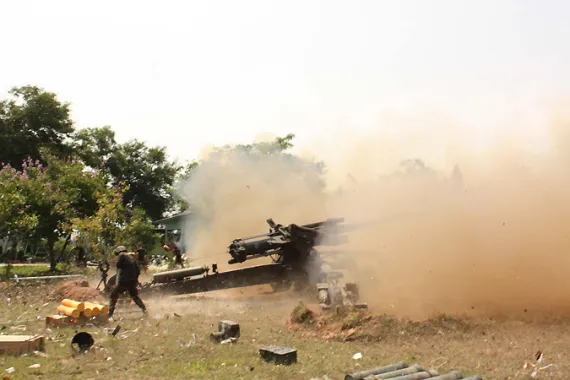Just a few days ago, on July 24, gunfire and shelling once again broke the peace along the Cambodia-Thailand border. So far, 14 people have been killed and 100,000 have been displaced due to the ongoing, most serious escalation in over a decade.
What started as a low-tension standoff turned into a deadly episode of hostility, raising international and regional security concerns by the minute.
This ongoing clash resulted from several triggering events that happened recently, one after another, but the question is, why does this fragile border keep getting fired at? History has all the answers.
Roots of the conflict
The traces of conflicts are often found in history, as the past holds all the secrets. To understand the current clashes, we must look back at a time before modern maps existed.
The basis of this cross-border conflict is Preah Vihear Temple, a majestic 11th-century Hindu shrine perched dramatically atop a cliff.
Despite the fact that in 1962, the International Court of Justice in its ruling announced that it belongs to Cambodia, the surrounding area of some 4.6 square kilometers of forested highland is still disputed as both countries claim it as part of their territory.
This small piece of land has been causing large-scale military standoffs in 2008, 2011, and now in 2025. No side is ready to accept the past compromises, and thus, the dispute remains active.
What triggered the current escalation
What exactly triggered the current escalation? The recent escalation didn’t just flare up overnight, but it has underlying reasons that triggered it.
On May 28, both sides clashed in the disputed border area of the Emerald Triangle, leaving one Cambodian soldier dead. The tri-border area connects Cambodia, Thailand, and Laos. Again, each side blamed the other for starting the violence.
Then, in early June, the Cambodian Prime Minister announced that their country is going to stop relying on Thai electricity and internet infrastructure due to threats. Cambodian TV channels stopped broadcasting Thai movies and shows, and vice versa.
During mid-June, the Thai Prime Minister held a call with Cambodian leader Hun Sen to discuss the current tensions, but on July 1, Thai Prime Minister Shinawatra was suspended after her call with Cambodian leader Hun Sen was leaked, where she criticized the Thai military for increasing tensions and Paetongtarn reportedly referred to Cambodian former Prime Minister Hun Sen as “uncle,” while labeling a Thai military commander as her “opponent.”
On July 16, a Thai soldier lost a leg in a landmine explosion while on patrol in the Chong Bok area of Nam Zuen district, Ubon Ratchathani, Thailand, further escalating tensions. A second blast occurred on July 23 that injured 5 Thai soldiers.
In response, Thailand immediately recalled its ambassador to Cambodia and expelled Cambodia’s envoy in Bangkok, and also shut down the border checkpoints at Chong An Ma, Chong Sa-ngam, Chong Chom, and Chong Sai Takoo. Ta Moan Thom and Ta Kwai temples also got closed.
Everything that has happened so far
On Thursday morning, July 24, armed fighting broke out between Cambodia and Thailand near the disputed area of Prasat Ta Moan Thom Temple, which is very close to the border. According to the Thai military, Cambodian troops deployed a surveillance drone at 7:35 am (00:35 GMT) before soldiers with rocket launchers approached a Thai military post.
Thereafter, Cambodian forces opened fire towards the eastern side of the temple, 200 metres (650ft) from the Thai military base, and also targeted a local community with rockets. Thai authorities said that in response, they dropped bombs through 6 F-16 Jets inside Cambodia that targeted two military posts of Cambodia.
Thai army deputy spokesperson Richa Suksuwanon told reporters, “We used air power against designated military positions”. The authorities also sealed the border crossing with Cambodia amid the chaos and unrest.
The Cambodian Defense authorities condemned the aerial assault and informed that two Thai bombs were dropped on public roads and not on military bases, and called the action a violation of Cambodia’s sovereignty. It is yet unclear who shot first, as both countries are blaming each other for initiating the attack.
The tensions got further increased on Thursday when Thai authorities informed that Cambodian forces shelled a Thai military base and also hit public areas, which include a hospital, as well which resulted in the killing of two civilians, and thousands were evacuated from villages near the border.
So far, on the third day of the current clashes, around 19 people have been killed in Thailand and 13 killed in Cambodia. On Friday, July 25, Thailand declared martial law in its eight districts.
ASEAN’s role in de-escalation
The Southeast Asian regional organization, ASEAN, is known for its cautious diplomacy in the face of current rising tensions and unrest; its silence begins to sound like complicity.
So far, there has been a mild statement issued from ASEAN that has urged restraint but hasn’t called for an emergency meeting or mediation.
Due to ASEAN’s non-interference policy, its effectiveness has often been limited in dealing with disputes, especially when one of the countries involved in the dispute, Thailand, is a regional power and a non-NATO ally of the United States.
A now or never situation
This clash is more of a casual cross-border conflict, as the United Nations Security Council has already announced to hold a private meeting under the agenda of “Threats to international peace and security” to discuss the clashes that erupted on Thursday.
If this sounds serious, that’s because it is. July’s Council President, Pakistan, has scheduled this meeting after Cambodia requested it in a letter on July 24. Both countries, Cambodia and Thailand, are expected to participate in the meeting under Rule 37 of the Council’s provisional rules of procedure.
The need of the hour isn’t just a ceasefire but a permanent solution, a mechanism to solve the border dispute once and for all. Because without that, after every few years, guns will return, civilians will die again, and history will repeat itself.
What is this headed?
Some possibilities might lead to peace and stability if, through joint dialogue under the United Nations or ASEAN the both countries agree to a temporary demilitarized zone and resume the stalled border talks.
But if national pride, political pressure, or miscommunication continues, this could evolve into a prolonged conflict, pulling in international actors and risking broader instability and security issues in Southeast Asia.
In the end, the real question remains that how many more lives must be lost before diplomacy is taken seriously?
An IR student whose interest lies in diplomacy and current affairs and a part time debater




